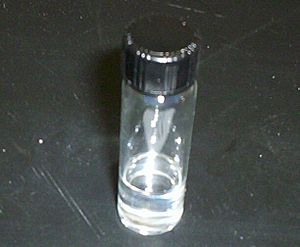Tin chloride facts for kids
Tin chloride is a name that can mean two different chemical compounds. Both of them contain the element tin and the element chlorine. The main difference between them is how many chlorine atoms are connected to the tin atom.
Contents
What is Tin Chloride?
Tin chloride refers to two important chemical compounds. These compounds are made from tin, which is a metal, and chlorine, which is a gas. The way tin and chlorine combine can create different substances. These substances have different properties and uses. Understanding these two types helps us see how chemistry works.
Tin(II) Chloride: The Stannous Kind
Tin(II) chloride is also known as stannous chloride. It is a colorless solid, meaning it looks like white crystals or powder. Its chemical formula is SnCl₂. This means each molecule has one tin atom and two chlorine atoms.
Tin(II) chloride is known as a reducing agent. This means it can give away electrons to other chemicals. When it does this, it helps other chemicals change. Think of it like a helper that makes other chemicals gain something.
What is Tin(II) Chloride Used For?
Tin(II) chloride has several interesting uses.
- Food Preservative: It can be used in small amounts as a food additive. It helps keep food from spoiling. You might see it listed as E512 on food labels.
- Dyeing Fabrics: It helps dyes stick better to fabrics. This makes colors brighter and last longer.
- Making Mirrors: It is used in a process to put a thin layer of silver onto glass. This is how some mirrors are made.
- Electroplating: It can be used to put a thin layer of tin onto other metals. This protects the metal from rust.
Tin(IV) Chloride: The Stannic Kind
Tin(IV) chloride is also called stannic chloride. Unlike tin(II) chloride, this compound is usually a clear, irritating liquid. Its chemical formula is SnCl₄. This means each molecule has one tin atom and four chlorine atoms.
Tin(IV) chloride is an oxidizing agent. This means it can take electrons from other chemicals. It helps other chemicals lose something. It is the opposite of a reducing agent.
What is Tin(IV) Chloride Used For?
Tin(IV) chloride is also used in different ways.
- Making Other Tin Compounds: It is often a starting material. Many other useful tin chemicals are made from it.
- Glass Coatings: It is used to put special coatings on glass. These coatings can make glass stronger or give it special properties. For example, it can be used for touchscreens or energy-efficient windows.
- Catalyst: In some chemical reactions, it acts as a catalyst. A catalyst helps a reaction happen faster without being used up itself.
How Are They Different?
The main differences between tin(II) chloride and tin(IV) chloride are:
- Appearance: Tin(II) chloride is a solid, while tin(IV) chloride is a liquid.
- Chemical Role: Tin(II) chloride is a reducing agent. Tin(IV) chloride is an oxidizing agent. They do opposite things in chemical reactions.
- Number of Chlorine Atoms: Tin(II) chloride has two chlorine atoms. Tin(IV) chloride has four chlorine atoms.
Both compounds are important in chemistry and industry. They show how changing the number of atoms in a molecule can lead to very different properties and uses.
Is Tin Chloride Safe?
Like many chemicals, tin chlorides need to be handled carefully. Tin(IV) chloride is an irritating liquid. This means it can cause discomfort if it touches skin or eyes. It's important for scientists and workers to wear safety gear. This includes gloves and eye protection. When used in products like food, they are in very small, safe amounts. Always remember that chemicals should be handled by trained adults.



